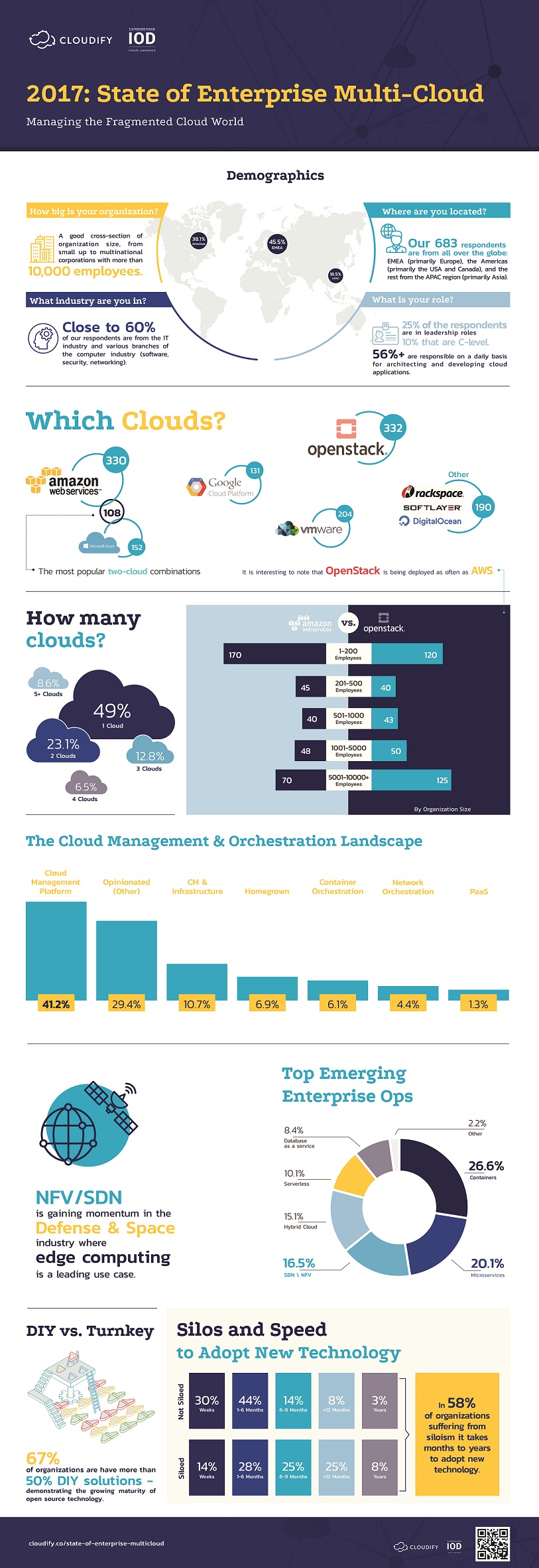Enterprise IT environments are becoming more heterogeneous and complex, with fragmentation permeating cloud infrastructure, tooling and culture, according to a survey recently conducted by IOD Cloud Technologies Research in partnership with Cloudify, titled 2017 State of Enterprise Multi-Cloud .
However, enterprises find common ground in the top business drivers for cloud: increasing operational efficiency and innovation.
Survey responses show that hybrid cloud is the dominant architectural model. Half of the organizations represented in the survey are managing more than one cloud, with close to 9 percent of enterprises deploying across five clouds or more.
The most popular two-cloud combination is AWS and Azure, which indicates that organizations are using public/public multi-clouds in order to avoid vendor lock-in. The second most popular two-cloud combination is AWS and OpenStack. Although AWS is more prominent among smaller organizations and OpenStack among larger ones, it is evident that public and on-premises clouds are living happily side by side across organizations of all sizes.
Fragmentation is also evident in the tooling layer and in IT culture. Organizations are using a wide range of cloud management tools, with no single vendor dominating the market, and two out of three respondents stated that their organization suffers, or may be suffering, from siloism.
In order to meet the challenges of fragmentation, the vast majority of organizations have introduced an orchestrator or similar management platform to coordinate workloads across IT environments. Orchestration is now at a level of maturity where it is managing the lion's share of production workloads and not just QA and PoC environments.
“Organizations are looking to the cloud for performance and innovation, but unfortunately they often find themselves in midst of a highly fragmented cloud world, where technologies are superfluous and incongruous, and where siloism is stifling agility and innovation,” said Nati Shalom, CTO of Cloudify. “In this fragmented world, the orchestration layer plays a critical panoramic role, especially in unifying multi-cloud and hybrid cloud environments, including the seamless integration of legacy software. Orchestration also plays a key role in eliminating silos, freeing organizations to be more agile, disruptive and innovative.”
Key findings of the survey:
■ Cloud Business Drivers: In popularity order, the benefits most sought after are:
- Increasing operational efficiency (38 percent)
- Disruption and innovation (28 percent)
- Standardization (13 percent)
- Avoiding vendor lock-in (12 percent)
- Saving money (9 percent)
■ Complex Deployments: Multi-cloud is most definitely the name of the game, with 50 percent of the organizations using more than one IaaS vendor. Nearly 85 percent of the multi-cloud organizations are managing up to 4 clouds, and a few are using as many as 8 or 9 vendors.
■ DIY vs. Turnkey Tools: Open source DIY tools, which were initially used by intrepid pioneers, have reached a maturity that makes them suitable for mass penetration. More than two-thirds of organizations have at least a 50/50 mix of open source DIY versus turnkey solutions.
■ Silos Abound: Two out of every three respondents believes or suspects that their organization suffers from siloism, and of those:
- 58 percent have separate IT and network departments within their organization (versus 25 percent in less-siloed organizations), and
- Ops joins software delivery meetings only 50 percent of the time (versus 64 percent in less-siloed organizations).
■ Orchestration in Production: Orchestration tools are no longer being deployed just for non-production workloads such as QA and proofs-of-concept — in 44 percent of organizations, production workloads are the highest priority workloads being orchestrated.
Methodology: IOD Cloud Technologies Research received 683 responses from IT professionals around the world: 45 percent from Europe, 38 percent from the Americas, and 17 percent from the Asia Pacific region. Industries represented included computer software (23 percent), IT and services (22 percent), telecommunications (17 percent), computer networking and security (12 percent), financial services and insurance (7 percent), government and academia (5 percent), and others (14 percent).


